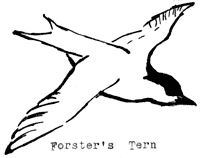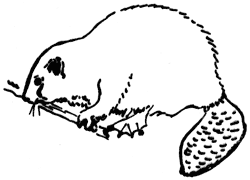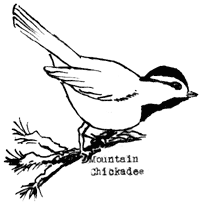Among woodpeckers, only the Modoc hairy has been reported within the park in mid-winter. He has appeared outside the mess hall looking for crumbs. His relative, the red-shafted flicker, does not remain all year, but returns early to the park, his lusty call resounding in the early months of the year.
Cheeriest of all winter birds is the tiny mountain chickadee, whose rollicky chick-a-dee-dee-dee seems to be stimulated rather than stilled by the gruffest storms. Sometimes their gay company is sought by a nuthatch, but in the park in winter, such an observation is rare.
The water ouzel should spend winter within the park, since there is open water here, but there do not seem to be any reports of his presence. February is his month of brilliant song, which is heard over the gurgling of the complementary half-frozen stream that is his home.
With late February, days of sunshine become more frequent, and summer residents may soon put in appearance. Thus a blackbird has been reported at Annie Spring in February, and a meadowlark ten days later. As early as March, robins, mountain bluebirds, and varied thrushes may come in the vanguard of migrants and summer residents. Juncos arrive from the lowlands, the siskins chirp as they fly from tree to tree, the woodland rings with the nasal “yank! yank!” of nuthatches. Not until snow has all but disappeared, with the song of the axe ringing in camp grounds, do the last of the host, among them the olive sided flycatcher and the nighthawk, complete the cycle of the year.
Forster’s Tern
By Dr. Ruth E Hopson
 Post mortem examination revealed that she had not eaten for some time as no sign of undigested food was found in the digestive tract. Since these birds are known to nest in the marshes of Upper Klamath Lake, it is probable that this bird was lost in the storm and was unable to find suitable food in the unsuitable habitats afforded by the rugged southern Cascades of which Crater Lake National Park is a part. This tern is a marsh loving bird which is not conditioned to timbered areas.On June 7, a female Forster’s tern, Sterna forsteri, was found dead near the Lost Creek Ranger Station at the East Entrance to the park. It was evidently a casualty of the storms of the first week of June. Forster’s terns have not previously been reported within Crater Lake National Park; this specimen can only be regarded as accidental.
Post mortem examination revealed that she had not eaten for some time as no sign of undigested food was found in the digestive tract. Since these birds are known to nest in the marshes of Upper Klamath Lake, it is probable that this bird was lost in the storm and was unable to find suitable food in the unsuitable habitats afforded by the rugged southern Cascades of which Crater Lake National Park is a part. This tern is a marsh loving bird which is not conditioned to timbered areas.On June 7, a female Forster’s tern, Sterna forsteri, was found dead near the Lost Creek Ranger Station at the East Entrance to the park. It was evidently a casualty of the storms of the first week of June. Forster’s terns have not previously been reported within Crater Lake National Park; this specimen can only be regarded as accidental.
Renewal of Beaver Activity in Copeland Creek
By W. S. Vincent, Ranger-Naturalist
Early this season the crew clearing out the Caste Creek Firetrail observed that beaver were damming the culvert at Copeland Creek. Other park employees reported additional signs of renewed activity to the naturalist’s office. On July 2 and July 16 I visited the area with Ranger-Naturalist O. L. Wallis.
 On July 16, it was noted that the willows have recovered. With their food supply replenished, the beavers have renewed activity along this stream. Nearly every one of the old dam sites had been or was in the process of being repaired. A considerable amount of water is being stored behind these dams in the area which extends about 250 yards below the firetrail. The restored dams range from five to fifty feet in width and from one to four feet in height. Behind one dam, the impounded water is backed up approximately one hundred feet. The total number of dams is about 15.Beaver had been very active in the Copeland Creek region for several years after 1931, when they first appeared in this section of the park. They soon exhausted the willows, their principal food here, and were forced to migrate to a more favorable habitat.
On July 16, it was noted that the willows have recovered. With their food supply replenished, the beavers have renewed activity along this stream. Nearly every one of the old dam sites had been or was in the process of being repaired. A considerable amount of water is being stored behind these dams in the area which extends about 250 yards below the firetrail. The restored dams range from five to fifty feet in width and from one to four feet in height. Behind one dam, the impounded water is backed up approximately one hundred feet. The total number of dams is about 15.Beaver had been very active in the Copeland Creek region for several years after 1931, when they first appeared in this section of the park. They soon exhausted the willows, their principal food here, and were forced to migrate to a more favorable habitat.
As my attention was drawn by a sudden disturbance on the bottom of one of the pools I saw a beaver departing from the immediate vicinity. A full view of the animal was obtained as it climbed over the dam and disappeared into the willows below the site. The beaver appeared to be full grown and in good condition.
From the amount of activity in the area, it is estimated that only one pair of beaver are working along the stream. The cuttings are somewhat scattered throughout the entire area with occasional cut branchlets submerged in open areas apparently used as food depots. No indication of lodge-building was noted.
In the 1946 issue of Nature Notes, Ranger-Naturalist Wallis reported no sign of fresh beaver activity in the Copeland Creek area, but some fresh workings along lower Annie Creek. Observations this year indicates that no new activity has taken place along Annie Creek.
Other indications of beaver activity in the park have been seen only in lower Bybee Creek, where a considerable number of fresh cuttings were observed and one quite large dam had been constructed. This particular dam was novel in that it was constructed in very fast water, and was five feet high and twenty feet across, backing up a pool forty feet long. Freshly peeled twigs of willow were noted in the dam but no other sign of the beaver was noted.


